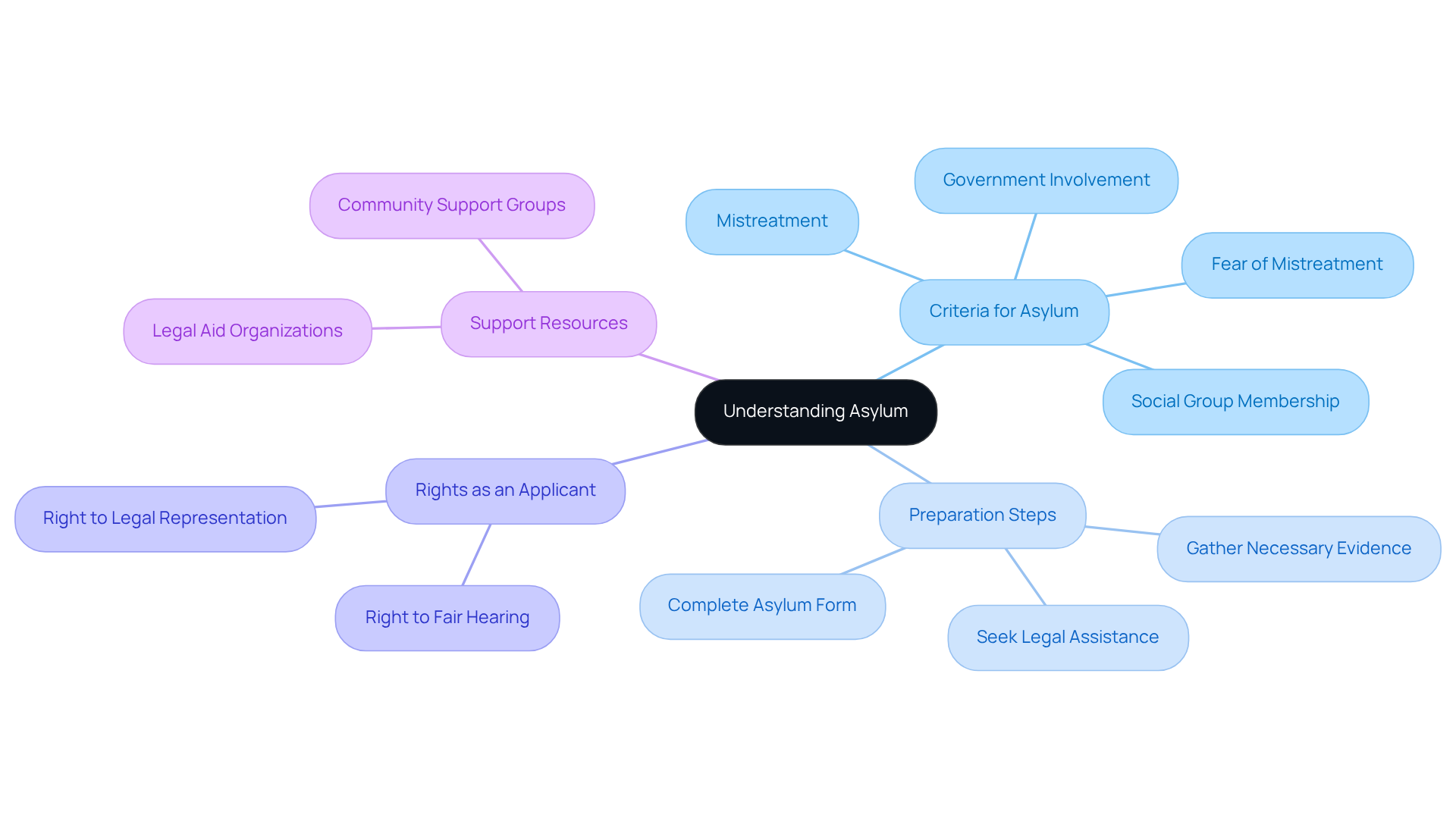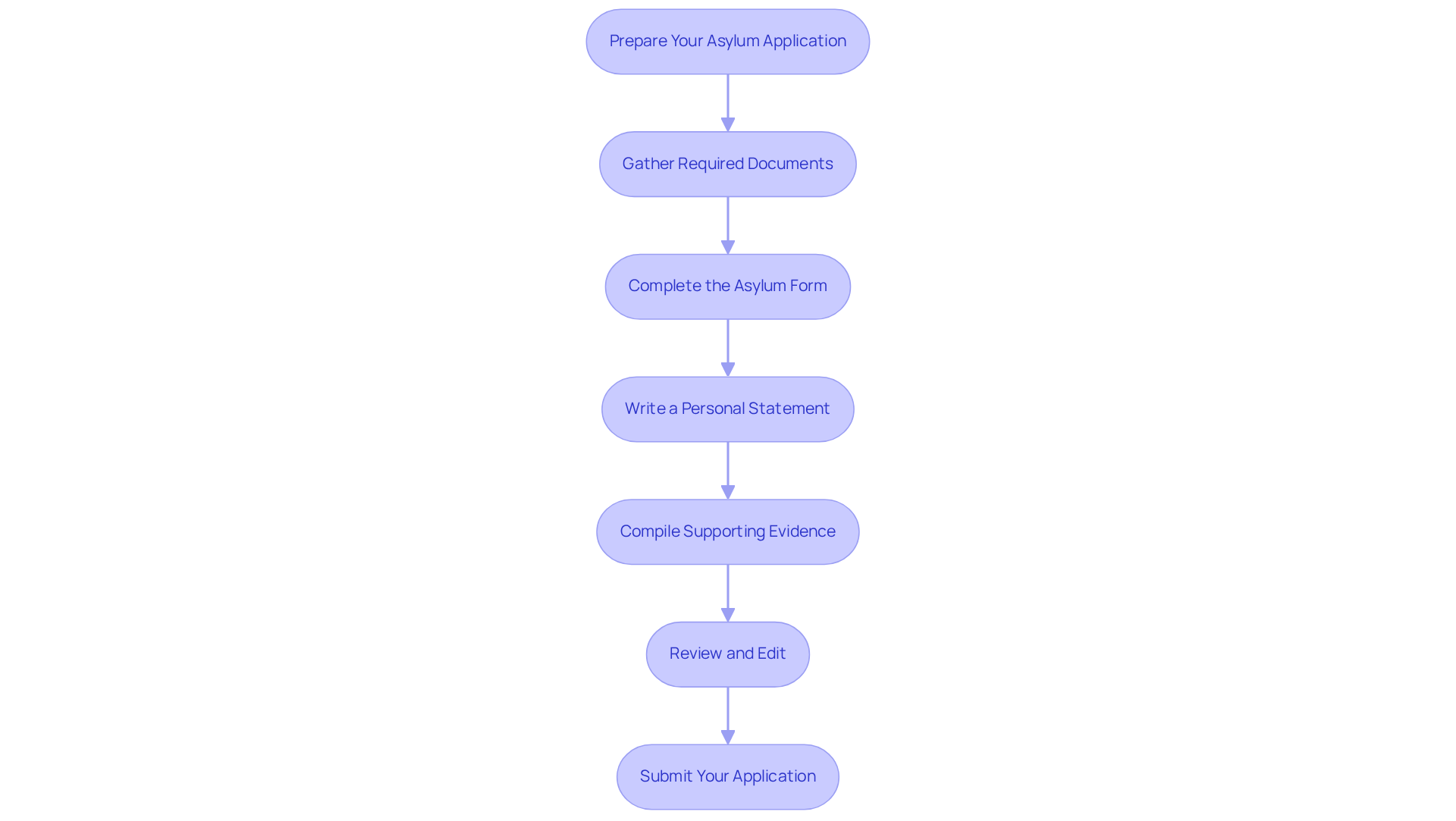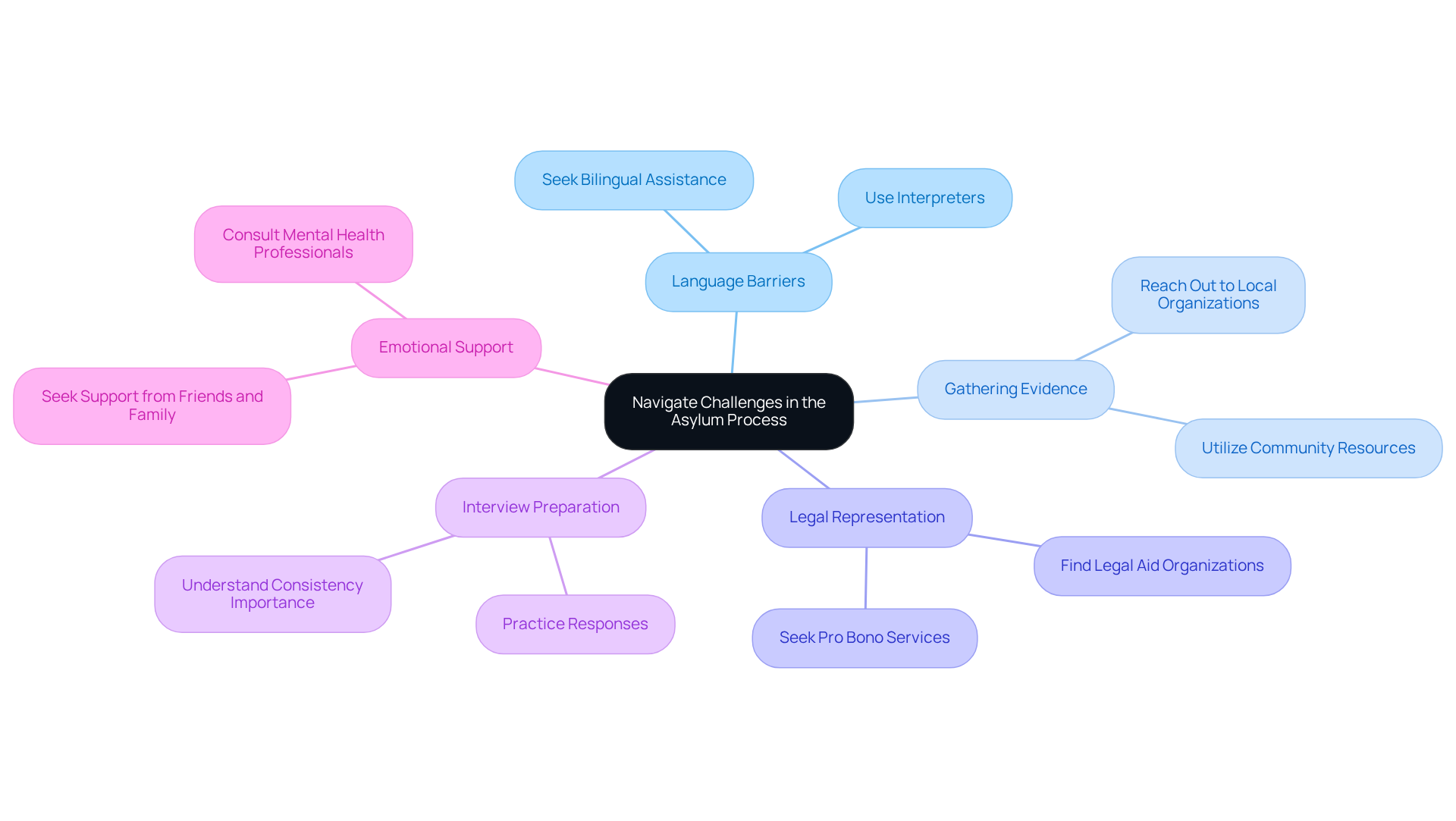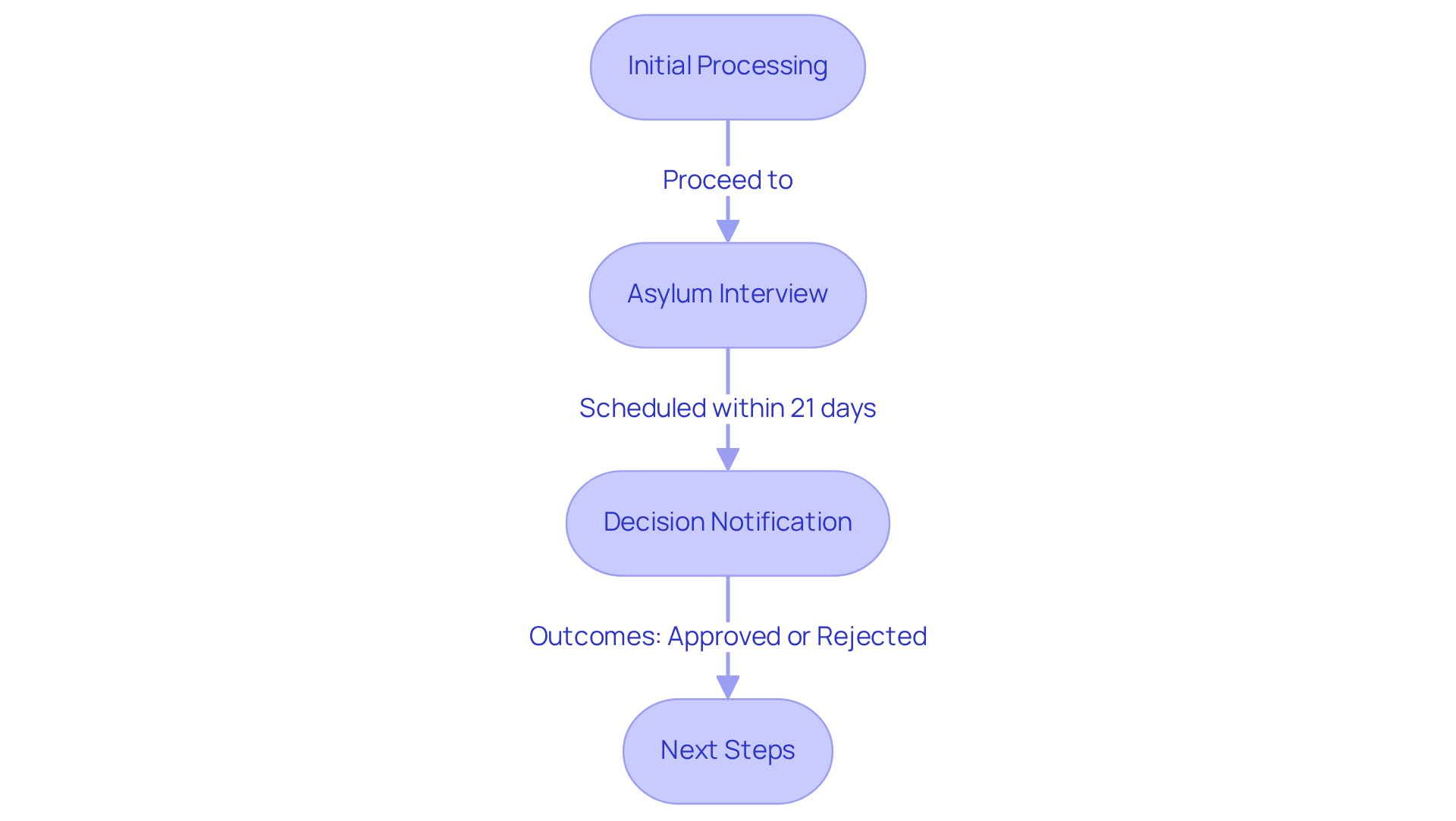Overview
This article serves as a compassionate and comprehensive step-by-step guide for immigrants seeking to complete their asylum form. It's important to remember that understanding the asylum process and preparing the necessary documentation can be daunting. This guide offers detailed instructions on:
- Gathering evidence
- Completing the application
- Navigating potential challenges
By empowering applicants with this knowledge, we aim to enhance their chances of securing asylum and finding the support they need during this critical time.
Introduction
Navigating the asylum application process can feel overwhelming for many individuals seeking refuge from persecution. It’s essential to understand the intricacies of completing the asylum form, as this document serves as a lifeline for those fleeing danger.
Careful attention to detail and proper documentation are vital. This guide offers a comprehensive, step-by-step approach to preparing an asylum application, addressing common challenges along the way. We provide valuable insights that can significantly enhance your chances of success.
However, with so much at stake, what are the critical elements that can make or break your asylum claim? It's important to remember that you are not alone in this journey.
Understand the Basics of Asylum
The asylum form is a vital means of global protection for individuals who have fled their home countries due to mistreatment or a genuine fear of mistreatment based on race, religion, nationality, political opinion, or membership in a specific social group. It’s important to understand that to qualify for this refuge, you need to demonstrate that you meet these criteria and that your government is either involved in the persecution or unable to control those who are.
Understanding these essential points is crucial. This knowledge will empower you to gather the necessary evidence and effectively prepare your asylum form. You may be feeling overwhelmed, but taking these steps can significantly enhance your chances of success.
Additionally, familiarize yourself with the terms and conditions of asylum, as well as the rights you hold as an applicant for protection. This preparation will help you feel more confident and ready for the next steps in your journey. Remember, you are not alone in this process, and seeking legal assistance can provide you with the support you need during this challenging time.

Prepare Your Asylum Application
Preparing your asylum form can feel overwhelming, but you're not alone in this journey. Here are some supportive steps to guide you through the process:
-
Gather Required Documents: Start by collecting essential documents like your passport, identification cards, and any proof of mistreatment, such as police reports, medical records, or witness statements. Remember, having these documents ready can help strengthen your case.
-
Complete the asylum form: Next, fill out Form I-589, which is the Application for Asylum and for Withholding of Removal. It's crucial to ensure that every section is completed accurately and truthfully, as this reflects your sincerity and commitment.
-
Write a Personal Statement: Draft a detailed personal statement that explains your reasons for seeking refuge. Include specific incidents of persecution that you have faced and how they relate to the asylum criteria. This is your chance to share your story and convey the urgency of your situation.
-
Compile Supporting Evidence: Organize your evidence clearly, referencing it in your personal statement. This may include news articles, expert affidavits, or country condition reports. Presenting your evidence well can significantly impact your application.
-
Review and Edit: Before submission, take a moment to review your documents for completeness and clarity. It might be helpful to have a legal expert or a trusted individual review it as well. This step can provide peace of mind knowing that your application is in good shape.
-
Submit Your Application: Finally, file your application with the appropriate immigration office. Make sure to keep copies of everything you submit for your records. It's important to remember that this step is a significant move towards securing your future.
By following these steps, you're taking important actions toward seeking safety and support. If you feel uncertain at any point, consider reaching out for legal assistance. You deserve guidance and care as you navigate this process.

Navigate Challenges in the Asylum Process
Navigating the immigration process can be challenging, and it's important to acknowledge the hurdles you may face. Here are some common issues and compassionate ways to address them:
-
Language Barriers: If English isn't your first language, seeking assistance from a bilingual attorney or interpreter can help ensure clear communication. Remember, you deserve to be understood.
-
Gathering Evidence: Obtaining necessary documentation can feel overwhelming. Consider reaching out to local organizations or community groups that can assist you in gathering evidence or provide valuable resources. You're not alone in this journey.
-
Legal Representation: If affording an attorney is a concern, look for legal aid organizations that specialize in immigration law. They can offer guidance and representation at little to no cost, helping you navigate the complexities of your situation.
-
Interview Preparation: Preparing for your immigration interview is crucial. Practice your responses to potential questions and understand the importance of consistency in your statements. This preparation can ease your anxiety and boost your confidence.
-
Emotional Support: The immigration process can take an emotional toll. It's essential to seek support from friends, family, or mental health professionals who can help you cope with stress and anxiety. Remember, seeking help is a sign of strength.
It's important to remember that these challenges are part of a larger journey, and there are resources and people ready to support you. Don't hesitate to reach out for help as you navigate this process.

Understand the Asylum Timeline and Next Steps
After submitting your asylum application, it’s important to understand the timeline and what to expect:
-
Initial Processing: Your submission will be assigned to an immigration officer for review. This can take several weeks to months, depending on the caseload. It’s important to remember that this waiting period can be challenging, and you are not alone in this experience.
-
Asylum Interview: You will be scheduled for an interview where you will present your case related to the asylum form. This usually happens within 21 days of submitting your request, but can differ. You may be feeling anxious about this step, and that’s completely normal.
-
Decision Notification: After your interview, you will receive a decision on your application. If your asylum form is approved, you will obtain refugee status; if it is rejected, you might have the opportunity to appeal. It’s crucial to stay hopeful during this time, as many people face similar situations.
-
Next Steps: If granted asylum, you can apply for a work permit and eventually for permanent residency. If denied, consult with an attorney to discuss your options, including the possibility of appealing the decision or seeking other forms of relief. Remember, there are paths forward, and seeking support can make a significant difference.

Conclusion
Completing an asylum application is a critical step for individuals seeking safety from persecution. While this process can feel daunting, it is possible to navigate it successfully with the right knowledge and support. Understanding the criteria for asylum, preparing the necessary documentation, and knowing the steps involved in the application process are essential for enhancing your chances of a favorable outcome.
Throughout this article, we have emphasized key points, including:
- The importance of gathering required documents
- Filling out Form I-589 accurately
- Writing a compelling personal statement
- Seeking legal assistance when needed
You may be facing common challenges as an asylum seeker, such as language barriers and the emotional toll of the process. Remember, there are resources available to support you.
Ultimately, the journey of seeking asylum requires resilience and determination. By following the outlined steps and utilizing available resources, you can approach the process with greater confidence. It’s important to remember that the pursuit of asylum is not just about paperwork; it is about seeking a safe haven and a new beginning. Taking action, seeking support, and remaining hopeful can make a significant difference in this challenging journey.
Frequently Asked Questions
What is the purpose of the asylum form?
The asylum form is a vital means of global protection for individuals who have fled their home countries due to mistreatment or a genuine fear of mistreatment based on race, religion, nationality, political opinion, or membership in a specific social group.
What criteria must be met to qualify for asylum?
To qualify for asylum, you must demonstrate that you meet the criteria of having fled your home country due to mistreatment or fear of mistreatment and that your government is either involved in the persecution or unable to control those who are.
How can understanding the asylum process help applicants?
Understanding the asylum process is crucial as it empowers applicants to gather the necessary evidence and effectively prepare their asylum form, enhancing their chances of success.
What should applicants familiarize themselves with regarding asylum?
Applicants should familiarize themselves with the terms and conditions of asylum, as well as the rights they hold as applicants for protection.
What resources are available for individuals navigating the asylum process?
Seeking legal assistance can provide support and guidance during the challenging process of applying for asylum.




